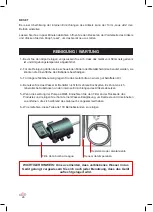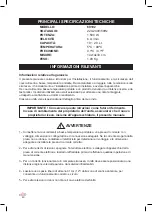
37
VACUUM COOKING
Included among the most important and new catering techniques are vacuum cooking and vacu-
um conservation. The advantages offered by these techniques are well adapted to the needs of
every kitchen: saving time, saving costs, better organizing the staff and longer-lasting products,
while also maintaining their sanitary and organoleptic qualities. These are some of the main rea-
sons that promise great success and a new way to conserve food. Vacuum cooking provides a
cooking technique that flips traditional ideas around. After getting used to our product, you will
enjoy the enhanced control of foods, whether in cooking or in conservation.
What is Vacuum Cooking?
Vacuum Cooking is when products are submitted to a vacuuming process and exposed to tem-
peratures that never exceed 100ºC. Due to the pressure difference, the boiling point of water can
be reached at a low temperature. The temperature penetrates the heart of the product linearly,
meaning that there are no air molecules and a radial reaction is not produced. Therefore, the
treatment and the results obtained with the product are perfectly controlled.
A simple way to explain Vacuum Cooking is that instead of cooking food at 130ºC for a relatively
short period of time, as is traditional, here they cook between 65ºC and 99ºC for longer periods
of time, depending on what type of food it is and its weight. In short, it is slow-cooked at a low
temperature. In a conventional oven, a piece of meat cooks at 200ºC, which causes the exterior
to get crunchy. However, the temperature inside the piece of meat rarely exceeds 50ºC. Therefore,
it is only necessary to have a temperature equal or slightly greater than 65ºC to cook food. This
technique also avoids the meat drying out and getting hard from being over-cooked.
ASPECTS TO CONSIDER FOR VACUUM COOKING
Vacuum Conservation and Vacuum Cooking cannot be practiced with rudimentary equipment.
This procedure does not allow for mediocrity and requires the raw materials to be extremely fresh.
It involves slow-cooking at low temperatures, where control is only reliable when working with very
precise ovens that feature maximum respect for sanitation during the entire process.
1.- Keep everything sanitary during the phases for packaging raw or cooked foods with the
vacuum, and for vacuum cooking. This entails perfectly cleaning the products, containers,
workspaces, as well as the hygiene and cleanliness of the people who carry out these tasks.
2.- Use quality, and undeniably fresh raw materials. If the food that is used is not very fresh, that
means that there are more germs at the start of the process, which means that the final
product will have more germs as well.
3.- Perfectly vacuum 99% of the time
4.- Cook the product by quickly turning to the desired temperature in order to get past the danger
zone as fast as possible (b10ºC and + 65ºC).
5.- Quickly cool any cooked product below +10ºC. This operation should be done in less than
90 minutes.
6.- Constantly monitor the staff’s health, hygiene and clothing. Never re-use the bags that have
been previously used to seal other products (very dangerous).
7.- Label the bags with the dates of manufacture and expiration.
8.- Store the packaged products in refrigerators at a temperature between 0ºC and +2ºC, and
respect this temperature until the time of heating and serving.
9.- In order to return to the serving temperature, it is necessary to act quickly in order to reach a
temperature greater than +65ºC in less than an hour and a half in the inner-most part of the
product according to the recommendations given by the health authorities.
















































